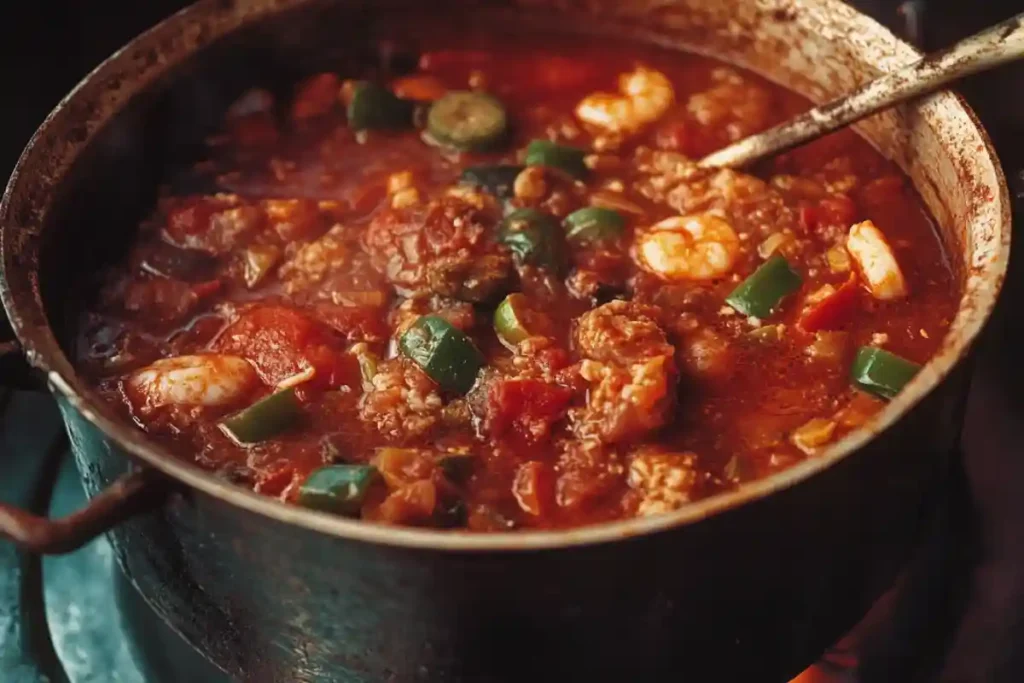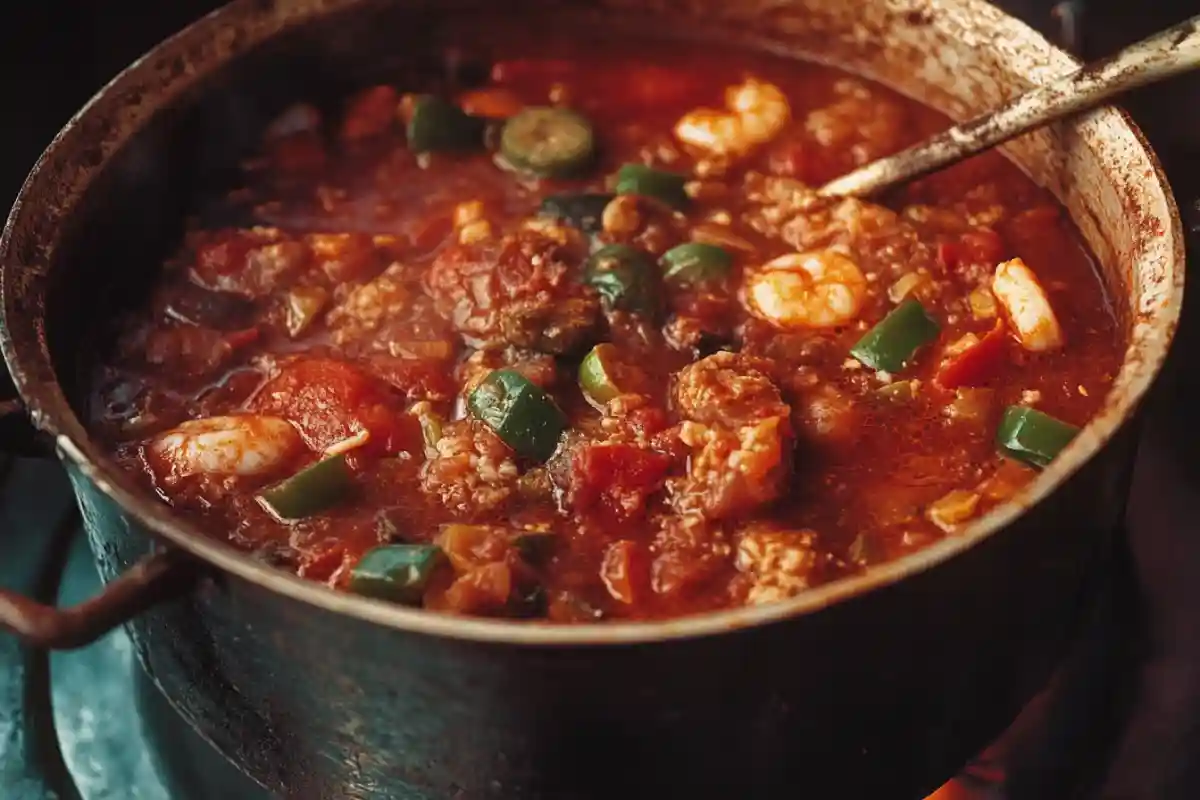
Table of Contents
Cajun Gumbo vs Creole Gumbo – Roux Color, Tomato Debate, and Spice Lineage
Ever wondered how Cajun gumbo vs Creole gumbo differ beyond the famed tomato question? I cooked five pots side-by-side—dark-roux Cajun chicken-sausage, lighter tomato-kissed Creole seafood—measuring roux shades, okra vs filé thickness, and spice heat. The result is a clear guide to choose or fuse both traditions at home.
Understanding the Roots of Gumbo
To truly appreciate the dish, it’s important to understand the story behind cajun gumbo vs creole gumbo. Both variations trace their roots to Louisiana, a melting pot of cultures where culinary influences blend seamlessly. While gumbo may seem like a simple stew, its origin tells a complex story shaped by migration, adaptation, and local flavor.
Historically, gumbo reflects a mix of West African, French, Spanish, and Native American cuisines. Each culture added something special, eventually creating the hearty dish we love today. Cajun gumbo, in particular, emerged from the kitchens of French-speaking Acadians who settled in rural Louisiana after being expelled from Canada. Their cooking style was resourceful and deeply rustic, relying on ingredients readily available from the bayou and countryside.
Meanwhile, Creole gumbo developed in more urban settings like New Orleans. This version was influenced by French, Spanish, Caribbean, and African communities, often incorporating tomatoes, seafood, and refined seasoning. Because Creole food had access to imported ingredients, it became known for elegance and depth. To learn more about how this flavorful fusion came to be, you can explore the rich history of gumbo as documented by food historians.
To fully experience this culinary legacy, you might also want to try other classic Louisiana dishes. One excellent place to start is this authentic Louisiana jambalaya recipe, which shares many of the same roots and spices as gumbo.
In short, gumbo is more than just a meal—it’s a cultural symbol. By learning about its origins, you gain insight into the spirit of Louisiana, where food is history, hospitality, and heart all simmered into one unforgettable bowl.
Cajun Gumbo vs Creole Gumbo: The Core Differences
When discussing cajun gumbo vs creole gumbo, it’s vital to understand the core differences that set these two delicious dishes apart. Although they share similar ingredients and cultural roots, several factors clearly distinguish one from the other. These differences go far beyond taste—they represent the heritage and lifestyle of the people who created them.
To help you compare easily, here’s how they differ:
1. Key Ingredients
- Cajun gumbo traditionally avoids tomatoes, focusing on a darker roux made from flour and oil.
- Creole gumbo, on the other hand, often includes tomatoes, giving it a brighter, slightly acidic flavor.
- Both rely on the “holy trinity” of onion, bell pepper, and celery.
2. Proteins Used
- Cajun gumbo typically features chicken and andouille sausage.
- Creole gumbo leans more toward seafood like shrimp, crab, and oysters.
3. Flavor and Technique
- Cajun dishes are often deeply smoky and spicy due to a longer roux cook time.
- Creole versions may use more herbs and have layered flavors with a refined finish.
4. Texture and Consistency
- Cajun gumbo tends to be thicker and heartier.
- Creole gumbo is sometimes soupier, depending on seafood content and tomato base.
Despite these differences, both styles represent the soul of Louisiana cuisine. Whether you lean rustic or elegant, there’s something to love in every bowl. If you’re planning to experience the real thing, check out where to find the best gumbo in New Orleans for an unforgettable taste test.
Together, they create a flavorful snapshot of Louisiana’s rich food heritage—proof that variety doesn’t divide; it enhances.
Regional Influence on Gumbo Styles
To fully appreciate cajun gumbo vs creole gumbo, it helps to look at where each version comes from. In fact, geography plays a major role in shaping the ingredients, cooking styles, and cultural values behind both types of gumbo.
Even though they’re both born in Louisiana, Cajun and Creole communities developed their own distinct approaches over time. Their cooking reflects the land and lifestyle that surrounds them.
Rural Cajun Country
In Cajun country, food was made with heart and practicality. Because rural areas lacked access to luxury ingredients, locals cooked with what they had on hand. This resulted in gumbo that was:
- Hearty and thick with dark roux
- Made with simple proteins like chicken and sausage
- Rich in spices and depth, but never reliant on tomatoes
To learn more about how Cajun cuisine developed into what it is today, check out this in-depth guide to Cajun food.
Urban Creole Cuisine in New Orleans
By contrast, Creole gumbo reflects the flavors of a port city with global influence. Due to trade and cultural fusion, Creole cooks had more to work with, resulting in:
- Tomato-based broths for a lighter finish
- Frequent use of shrimp, crab, and oysters
- Elegant spices like thyme and parsley for a French touch
Let’s compare both regions side-by-side:
| Feature | Cajun Gumbo | Creole Gumbo |
|---|---|---|
| Location | Rural Louisiana (Bayou) | New Orleans (urban areas) |
| Base Flavor | Dark roux, no tomato | Lighter roux with tomatoes |
| Common Proteins | Chicken, sausage | Seafood (shrimp, crab, oysters) |
| Cooking Method | One-pot, rustic style | Layered, refined preparation |
As you can see, the setting has everything to do with the gumbo’s final flavor. That’s why the debate over cajun gumbo vs creole gumbo isn’t just about taste—it’s about tradition, too.
Common Misconceptions About Cajun and Creole Gumbo
While many food lovers appreciate both styles of gumbo, confusion still surrounds the cajun gumbo vs creole gumbo debate. This is not surprising, especially since both dishes often share ingredients and cooking methods. However, several widespread myths continue to blur the line between the two.
Let’s clear up the most common misunderstandings:
- Myth 1: All gumbo is spicy.
Although gumbo can have bold flavors, not every version is packed with heat. In fact, Cajun gumbo tends to be earthier and smokier, while Creole gumbo offers a more balanced flavor profile. - Myth 2: Tomatoes = Cajun.
This is a big one. Tomatoes are actually a defining ingredient in Creole gumbo, not Cajun. If you spot tomatoes in a gumbo, it likely falls on the Creole side. - Myth 3: Creole is just a fancy version of Cajun.
While Creole cooking may appear more refined due to its urban roots, both traditions are deeply authentic and flavorful in their own right. - Myth 4: You can’t mix styles.
Many modern chefs—and even home cooks—blend elements from both to create hybrid versions that honor the best of both worlds.
Because the cajun gumbo vs creole gumbo comparison is so nuanced, understanding these myths helps you appreciate the complexity behind each dish. As you dive deeper into their differences, you’ll also develop a new respect for their shared cultural heritage.
FAQs
What is the difference between Cajun and Creole gumbo?
The main difference between Cajun gumbo and Creole gumbo lies in the ingredients and the cultural roots behind each version. Cajun gumbo typically features a dark roux, no tomatoes, and proteins like chicken or sausage. It reflects the rural, rustic cooking of French Acadian descendants. In contrast, Creole gumbo often includes tomatoes and a variety of seafood, such as shrimp and crab, reflecting the more urban, globally influenced cuisine of New Orleans. While both are rich and flavorful, their unique characteristics are what define the cajun gumbo vs creole gumbo conversation.
What are the three types of gumbo?
The three most well-known types of gumbo are seafood gumbo, chicken and sausage gumbo, and gumbo z’herbes. Seafood gumbo usually includes shellfish and is more closely associated with Creole cooking. Chicken and sausage gumbo, often Cajun in style, has a deep, smoky flavor with no tomato base. Gumbo z’herbes is a lesser-known, greens-based version traditionally made during Lent. Together, they each showcase a unique part of the cajun gumbo vs creole gumbo legacy.
What is the difference between a Cajun and a Creole?
Cajuns are descendants of French-speaking settlers from Canada who made their homes in rural Louisiana. Their culture is deeply rooted in resourceful, rustic cooking that uses what’s locally available. Creoles, on the other hand, have a more mixed heritage that often includes French, Spanish, African, and Caribbean ancestry, with ties to the city of New Orleans. This cultural difference directly influences the flavors and styles found in cajun gumbo vs creole gumbo, making both expressions of their rich histories.
What makes gumbo Creole?
Gumbo is considered Creole when it includes tomatoes, features seafood like shrimp or crab, and uses more delicate seasoning techniques, often incorporating herbs like thyme and parsley. The result is a brighter, more balanced dish with a lighter broth compared to the earthier tones of Cajun gumbo. This distinction helps define the unique identity of Creole gumbo in the larger cajun gumbo vs creole gumbo discussion.
Final Thoughts: Celebrating Both Gumbo Traditions
In the end, choosing between cajun gumbo vs creole gumbo isn’t really about picking a winner—it’s about appreciating the rich cultural roots behind both. Each version tells a story shaped by history, geography, and tradition. While Cajun gumbo offers a hearty, smoky comfort that speaks to rural resilience, Creole gumbo delivers a refined, balanced flavor inspired by the diverse influences of New Orleans. Both styles carry a sense of identity and pride that can be tasted in every bite.
Moreover, understanding the differences doesn’t have to divide us. Instead, it brings us closer to the heart of Louisiana cuisine, where diversity is not only embraced but celebrated. So whether you’re simmering a dark roux or stirring in fresh Gulf shrimp, you’re participating in something much bigger than a recipe. You’re honoring generations of food, culture, and connection—exactly what makes cajun gumbo vs creole gumbo so beloved by all who try it.

